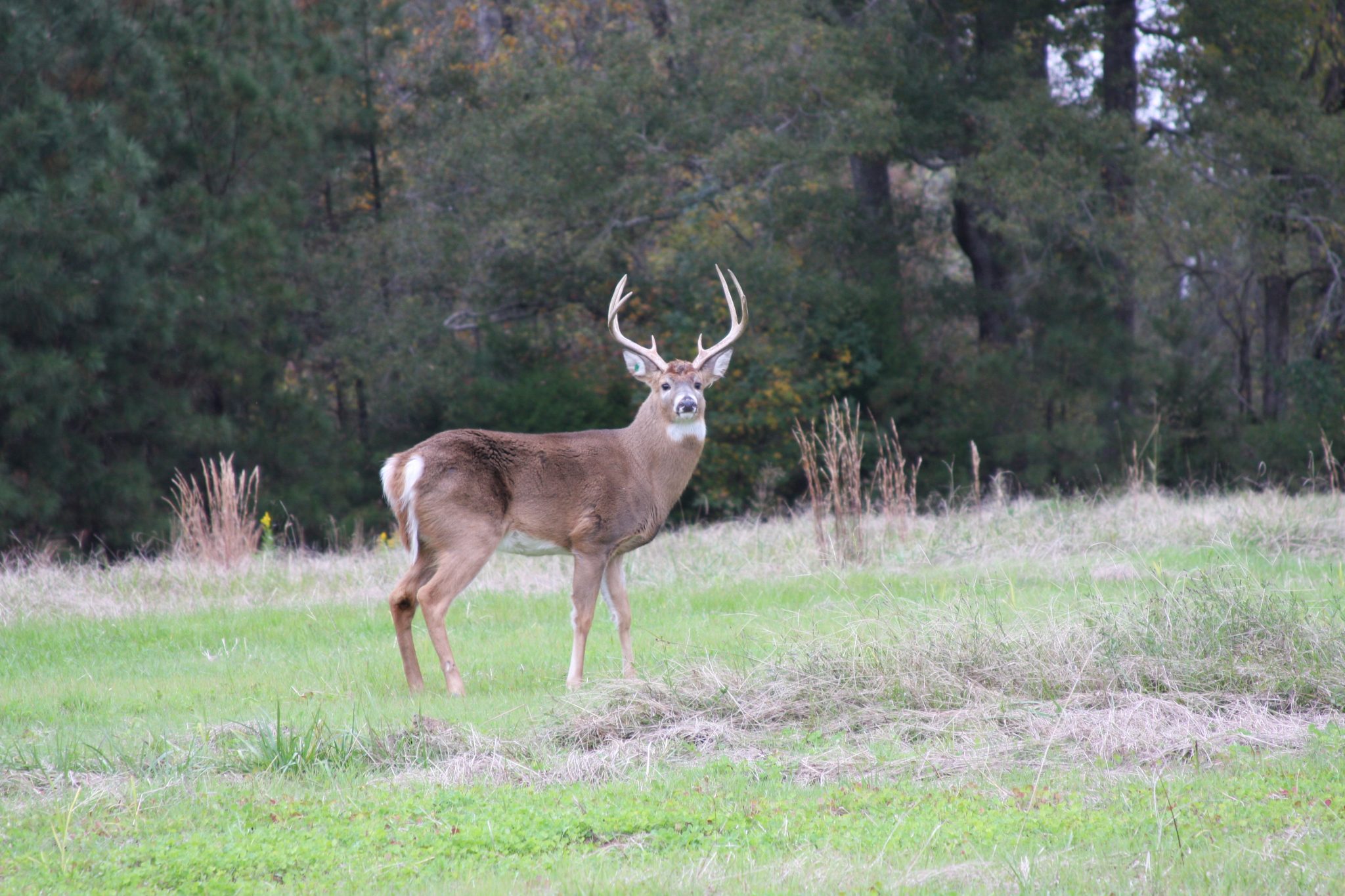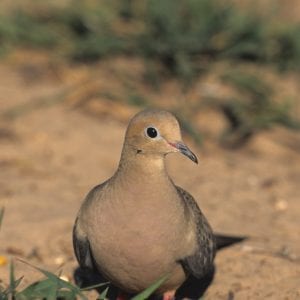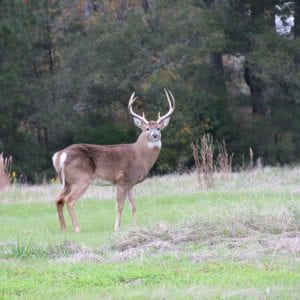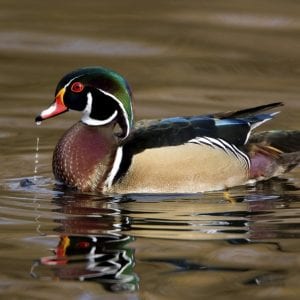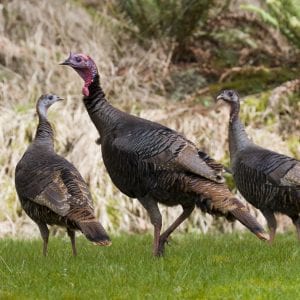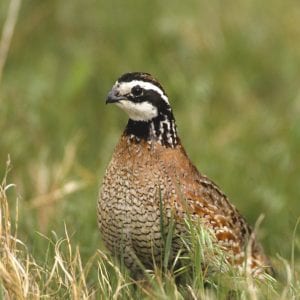Forestry & Wildlife

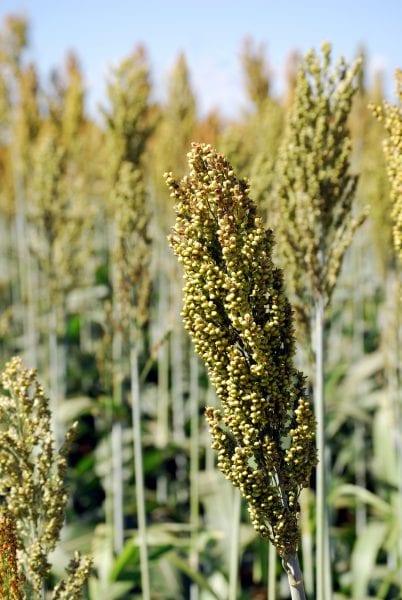
Figure 1. Plantings can be used to increase overall habitat quality of your property for wildlife.
Three of the most important requirements for game and nongame wildlife are shelter (cover), food, and water. Increasing or decreasing the abundance of a particular wildlife species on your property will be a matter of altering the relative amounts of these basic requirements.
Water seldom limits wildlife populations in Alabama, so there is little need to manage water except to attract waterfowl. In some areas, the availability of food may be a limiting factor. However, the lack of adequate cover for nesting, foraging, escaping predators, or raising young is frequently the most limiting factor on many properties. Before you begin planting for wildlife, determine which, if any, of these requirements are lacking on your property. Keep in mind that habitat requirements vary considerably among wildlife species. Consider what species you are trying to manage before making planting decisions. What may be good for one species may not be good for another.
Although cover and food can be planted, it is frequently much easier and cost effective to preserve or manage habitat already on your property. Actively managing existing habitat, such as forests and open areas, will provide many of the cover and food requirements of wildlife. For example, pine stands can be thinned (removing select trees within the stand) to allow sunlight to reach the forest floor to stimulate the growth of grasses and forbs that wildlife use for food and cover. Or in hardwood stands, trees that do not produce mast (fruit and nuts) can be removed to allow greater growing space for mast-producing trees. Numerous management techniques can be used to create or enhance the quality of existing habitat for wildlife on a property. Therefore, whenever possible, it is important to also consider these management options.
Things to Consider
Wildlife plantings can be of single or multiple plant species. Although plants in this guide are listed individually, you may want to plant mixtures of several different species depending on your objectives. For example, it is much easier to plant and maintain a food plot of only one species; however, if planting native grasses for cover, it will be important to include several species to increase diversity. Care must be taken when mixing plant species, because some plants will not grow well in the presence of others. When considering planting mixed species vegetation, check species compatibility as well as planting recommendations. If you plant only annual species (plants that germinate, flower, and then die in a year), stagger the planting dates to ensure that plants mature at different times. Either technique—mixing varieties or staggering planting dates—will provide a longer period of food availability.
It is important to properly prepare the site for planting. A soil test is always a wise investment before planting. Results from a soil test will provide information on fertility needs and recommendations for establishing a successful stand. In many cases, you will need a well prepared seedbed before planting. This may require mowing, tillage, and/or preemergent weed control through herbicide application. (Seedbed preparation requirements and techniques depend on seeding method used.)
Depending on the nature of the wildlife planting and the plant species used, follow-up maintenance may be required. It is important to continually monitor the progress of your wildlife planting. In some cases, it may be necessary to apply a selective herbicide to control unwanted “weeds” that invade a wildlife planting. Maintaining fertility by adding fertilizer and lime, when needed, will also prolong stand persistence and potentially increase vegetative growth. Some plants, such as native grasses that are adapted to fire, require periodic prescribed burning to maintain the stand.
Generally, wildlife is found along edges where two or more kinds of vegetation meet. The diversity of plants is greatest at edges, so more food items and cover materials are available. In most cases, and especially with food plots, it is important to maximize edge. Food plots should be relatively small, long, and narrow. In extremely large plots, the center of the plot may never be used by some species because it is far away from an edge.
Management and Planting Suggestions for Selected Game Species
Mourning Dove
In most areas, mourning doves are managed by planting fields for dove shooting. Fields should be approximately 5 to 10 acres in size. Larger fields can be planted if they are long and relatively narrow. If hunters will be posted on both sides, the field should be at least 100 yards wide. Fields near a good water supply are more preferred than those far from water. This is especially true during dry years. Limit shooting to once or twice a week, and stop well before sunset to give doves time to feed and roost near the field.
When planting in rows or with a drill, alternate rows of planted and nonplanted areas. During the shooting period, disk or plow bare areas. Mechanically harvested, hogged-off, or mowed fields are attractive to doves. Whenever possible, stagger these practices to extend the time that food is available to doves. See Extension publication ANR-1467, “Mourning Dove Biology and Management in Alabama,” for additional information regarding mourning dove management.
Plants that may be used in dove fields include an annual game-bird mixture, corn, corn and soybean mixture, brown-top millet, proso millet (one of the best overall), brown-top millet and grain sorghum mixture, and the various peas, sesame, and sorghum-soybean-millet mixtures.
White-tailed Deer
One of the most important aspects of deer management is regulated harvest. Food is a problem in areas where deer are under harvested and populations are too high. Once an area’s capacity to support animals has been reached, the excess deer must be removed to prevent damage to the habitat. Older aged pine woodlands can be managed for deer by prescribed burning at 3- to 5-year intervals and by timber harvesting and thinning. When cuttings are made, openings should be large enough to encourage growth of the young, tender plants that deer eat. Whenever possible, leave mast trees (trees that produce fruits and nuts).
Food plots should be no less than 1 acre and may be 3 to 5 acres or more. Up to 10 percent of your total acreage can be put into food plots. Suggested plants include alfalfa, chicory, clovers, clover and small grain mixtures, corn, corn and soybean mixtures, oats, winter rye, ryegrass, soybeans, cowpeas, and wheat. For additional information on food plots for white-tailed deer, see the Alabama Department of Conservation and Natural Resource’s Division of Wildlife and Freshwater Fisheries publication “Effective Food Plots for White-Tailed Deer in Alabama” available for free online.
- Figure 2. The mourning dove, Alabama’s most popular game bird, prefers plantings of small grains.
- Figure 3. As a general rule of thumb, about 5 to 10 percent of your property should be put into food plots for white-tailed deer.
- Figure 4. High-energy foods such as corn should be planted, and once mature, flooded to attract waterfowl.
Ducks
In general, farm ponds cannot be managed intensively for fish and ducks, because managing duck food plants will interfere with fish production. Duck management areas must have water control devices to allow drainage before the growing season so food plants can germinate and grow during the summer months before these areas are reflooded just before the hunting season, usually the latter part of October. These shallow water areas are referred to as moist soil management units. Within these units, you may either plant high-energy foods, such as corn, or manage the naturally occurring vegetation by disking the area to stimulate germination of the seed bank.
Ponds without water control can be managed for ducks by planting edges with Japanese millet. Best results can be expected in ponds with feathered edges that drop off very gradually. It is possible to manage natural bodies of water for ducks, particularly beaver ponds. In early July, drain the pond and use a Clemson beaver pond leveler to prevent beavers from flooding the area. Plant Japanese millet on the exposed mud flats, or lightly disk the area to stimulate the growth of native plants, and then flood the area just before the hunting season. Wood ducks are the most abundant duck species that nests in Alabama. Wood ducks nest in tree cavities; however, they will readily use nest boxes if provided. In the South, they remain in the local area, so you can help build numbers by providing nest boxes. See Extension publication ANR-0519, “Wood Duck Management in Alabama,” for nest box designs.
The shooting schedule depends on the size of the management area. However, there should be no more than three hunts per week. Schedule the shoots for morning hours only so ducks will return for roosting and remain in the area longer. Doing so will usually help maintain hunt quality.
Plants that can be used in duck ponds include corn, corn and soybean mixtures, browntop millet, Japanese millet, browntop millet and grain sorghum mixtures, and nodding smartweed. Keep in mind, there may be many native plants already in the seed bank that, if properly managed, will provide abundant food for ducks at less cost than planting. Check the U.S. Fish and Wildlife Service guidelines regarding manipulation of standing crops and vegetation for duck management areas.
Turkeys
Effective turkey population management requires a greater area than many landowners have—usually 1,000 acres or more. You can, however, provide areas of food and cover on smaller tracts to attract turkeys during certain times of the year. Woodlands should have hardwoods in the bottom and a mixture of hardwood and pine in the uplands with openings scattered throughout. At least half and up to two-thirds of the area can be in openings—natural or human-made, permanent or short-term. Seed trails or roads through the woodlands with clover or grass mixtures.
Nesting and brood rearing habitat is frequently the most limiting factor for wild turkey populations. Actively managing natural habitat will remedy this problem. For example, prescribed burning within older aged pine stands can help maintain a relatively open understory. Burning should be on a 3- to 5-year cycle.
For additional information about turkey management, see Extension publication ANR-0512, “Wild Turkey Management in Alabama.”
Human-made openings and food plots should be a minimum of 1 acre and ideally 3 to 5 acres. If deer are present, it may be necessary to make food plots and openings 2 to 10 acres to prevent plots from being devoured by deer. Plants suitable for turkey management include annual game-bird mixture, chufa (a popular option), clovers, clover and grass mixtures, corn, corn and soybean mixtures, browntop millet, millet and grain sorghum mixtures, oats, peas, winter ryegrass, sunflowers, and wheat.
- Figure 5. Food plots, especially if planted with chufa, can be used to attract turkeys.
- Figure 6. Native grasses such as big bluestem provide excellent cover for bobwhite quail.
Bobwhite Quail
Proper cover is the primary limiting factor for quail, specifically early succession plant communities. These natural plant communities are characterized by annual grasses and forbs, such as ragweed, foxtail, goldenrod, and partridge pea that first appear/sprout up after the soil has been disturbed or the surface substrate (old dead plant material) has been removed, exposing the soil to sunlight. These plant communities require continued, periodic management. Another management technique, primarily in farmlands, is to farm relatively small fields. When fields are separated by fencerows and allowed to grow native vegetation, they can be very good for bobwhites. Even when fields are large and fencerows nonexistent, certain techniques will increase the number of quail. For example, leaving noncultivated areas (field borders) around the edges of row-crop fields may encourage partridge pea and other native food and cover plants.
Alabama Wildlife Planting Guide
* B: Broadcast D: Drill M: Mixed R: Rows
* Native warm-season grasses require special equipment and/or additions to ensure successful planting (excludes switchgrass)
* Planting dates encompass all of Alabama and are not location specific
| Crops | Planting Date | Seeding Rate (lb/acre)* | Planting Depth (inches) | Growth Type |
|---|---|---|---|---|
| Alfalfa | Aug. 15-Nov. 1 | B: 20 to 25; D: 18 to 25 | 0 to 1/4 | Warm-season: Perennial |
| Alyceclover | May 1-July 15 | B: 15 to 20 | 1/4 to 1/2 | Warm-season: Annual |
| Arrowleaf clover | Sept. 1-Nov. 1 | B: 5 to 10 (scarified) | 0 to 1/4 | Cool-season: Annual |
| Austrian winter pea | Sept. 1-Nov. 1 | B:35 to 40; D: 30 to 35 | 1 to 2 | Cool-season: Annual |
| Bell clover | Sept. 1-Oct. 30 | B: 3 to 5 | 0 to 1/4 | Cool season: Annual |
| Barley | Sept. 1-Oct. 30 | B: 3 to 5 | 0 to 1/4 | Cool-season: Annual |
| Big bluestem | March 1-May 10 | B: 9 to 12; D: 7 to 9 | 1/4 to 1/2 | Warm-season: Perennial |
| Birdsfoot trefoil | Sept. 1-Oct. 30 | B: 8 to 10; M: 4 to 5 | 0 to 1/4 | Cool-season: Perennial |
| Blue lupine | Sept. 15-Nov. 1 | B: 100 to 120; D: 5 to 75 | 1 1/2 | Cool-season: Annual |
| Brassicas (rape, kale, turnip, canola) | Sept. 1-Oct. 15 | B: 8 to 10; D: 5 to 8 | 0 to 3/4 | Cool-season: Annual |
| Browntop millet | April 1-Aug. 15 | B: 25 to 30; D: 15 to 20 | 1/2 to 1 | Warm-season: Annual |
| Buckwheat | April 15-June 1 | B: 50 to 60; D: 30 to 40 | 1/4 to 1/2 | Warm-season: Annual |
| Button clover | Sept. 1-Oct. 15 | 15 to 20 | 1/4 to 1/2 | Cool-season: Annual |
| Caley peas | Sept. 1-Oct. 30 | B: 50 to 55 | 1/2 to 1 | Cool-season: Annual |
| Chicory, forage | Aug. 15-Oct. 15 | D: 4 to 5; M:2 to 3 | 1/4 to 1/2 | Perennial Forb |
| Chufa | April 1-June 30 | B:40 to 50 | 3/4 to 1 | Warm-season: Perennial |
| Corn | March 15-June 1 | R: 7 to 10 | 1 to 2 | Warm-season: Annual |
| Cowpeas | May 1-July 1 | B: 100 to 120; R: 30 to 40 | 2 to 3 | Warm-season: Annual |
| Crimson clover | Sept. 1-Nov. 1 | B: 20 to 30 | 1/4 to 1/2 | Cool-season: Annual |
| Eastern gamagrass | March 1-July 15 | D: 8 to 14 | 1/2 to 1 | Warm-season: Perennial |
| Egyptian wheat | April 1-July 15 | B: 12 to 15; R: 8 to 10 | 3/4 to 1 | Warm-season: Annual |
| Florida beggared | April 15-June 15 (Last cultivation of corn) | B: 10 to 12 | Leave uncovered | Warm-season: Perennial |
| Foxtail millet | April-July 1 | D: 15 to 20; B: 25 to 30 | 1/2 to 3/4 | Warm-season: Annual |
| Indiangrass | April 1-June 15 | B:10 to 12; D: 7 to 9 | 1/4 to 1/2 | Warm-season: Perennial |
| Japanese millet | May 1-Aug. 1 | B: 20 to 25; D: 15 to 20 | 1/4 to 1/2 | Warm-season: Annual |
| Lablab | April 15-June 30 | B: 8 to 10 D: 5 to 7 | 1 to 2 | Warm-season: Annual |
| Lespedeza, kobe | Feb. 15-March 31 | B: 20 to 30; D:15 to 20 (scarified) | 0 to 1/4 | Warm-season: Annual |
| Lespedeza, Korean | Feb. 15-March 31 | B: 25 to 35 | 0 to 1/4 | Warm-season: Annual |
| Little bluestem | April 15-May 30 | B: 9 to 12; D: 7 to 9 | 1/4 to 1/2 | Warm-season: Perennial |
| Oats | Aug. 15-Oct. 30 | B: 90 to 120; M 60 to 90 | 1 to 2 | Cool-season: Annual |
| Partridge pea | Feb. 1-May 1 | B: 15 to 20; D: 5 to 10 (scarified) | 1/4 to 1/2 | Warm-season: Annual |
| Pearl millet (forage) | April 1-July 15 | D: 12 to 15; B: 25 to 30 | 1/2 to 1 1/2 | Warm-season: Annual |
| Proso millet | May 1-June 30 | D: 10 to 20; B: 20 to 30 | 1/2 to 3/4 | Warm-season: Annual |
| Red clover | Sept. 1-Nov. 15 | B: 12 to 15; D: 8 to 10 | 1/4 to 1/2 | Cool-season: Annual |
| Rye | Aug. 15-Nov. 1 | B: 90 to 120; M: 60 to 90 | 1/2 to 1 | Cool-season: Annual |
| Sesame (benne) | April 1-June 15 | D: 2 to 4 | 1/4 to 1/2 | Warm-season: Annual |
| Sorghum (forage) | April 15-July 1 | B: 15 to 20 | 1 to 2 | Warm-season: Annual |
| Sorghum-Sudan hybrids | April 1- Aug. 15 | B: 30 to 35; D: 20 to 25 | 1/2 to 1 | Warm-season: Annual |
| Soybeans (wildlife) | April 15-June 15 | D: 60 to 100 | 1 to 3 | Warm-season: Annual |
| Subterranean clover | Sept. 1-Oct. 15 | B: 8 to 10 | 0 to 1/4 | Cool-season: Annual |
| Sudangrass | May 1-Aug. 1 | B: 30 to 40; D: 2 to 4 | 1 to 2 | Warm-season: Annual |
| Sunflower | April 1-June15 | D: 2 to 4 | 1 to 2 | Warm-season: Annual |
| Sunn hemp | March-Aug. (one week after frost free) | B: D: Alone: 15 to 50; Mix: 7 to 10 | 1/4 to 1 | Warm-season: Annual |
| Sweetclover | Sept. 1-Oct. 30 | B: 12 to 15 | 1/4 to 1/2 | Cool-season: Annual or Biennial |
| Switchgrass | March 1-July 15 | B: 35 to 6 D: 4 to 5 | 1/4 to 1/2 | Warm-season: Perennial |
| Triticale | Aug. 15-Oct. 15 | B: 90 to 120; M: 60 to 90 | 1 to 2 | Cool-season: Annual |
| Common vetch | Sept. 1-Nov. 15 | B: 30 to 40 | 1 to 2 | Cool-season: Annual |
| Hairy vetch | Sept. 1-Nov. 1 | B: 25 to 35 | 1 to 2 | Cool-season: Annual |
| Wheat | Aug. 15-Nov. 1 | B: 90 to 120; M: 60 to 90 | 1 to 2 | Cool-season: Annual |
| White clover | Sept. 1-Nov. 15; Feb. 1-April 1 | B: 2 to 4 | 0 to 1/4 | Cool-season: Perennial |
Older aged pine stands should be burned using Alabama Forestry Commission prescriptions. On fertile soils, it may be necessary to burn annually from January to March. But for most areas, a 2- to 3-year burning rotation will be sufficient. If there is an annual burning regime on infertile soils, leave small patches unburned to provide nesting cover. Before burning, contact your county office of the Alabama Forestry Commission.
Food plantings should be long and narrow and located adjacent to suitable cover. Additional woody cover can be created by planting low-growing woody plants such as plums. Food plots for quail include Egyptian wheat, partridge pea, millets, annual gamebird mixture, Florida beggarweed, corn, corn and soybean mixtures, annual lespedeza (Korean, kobe, common), peas, sorghum, soybeans, and vetch. Big bluestem, little bluestem, Indiangrass, and eastern gamagrass provide excellent cover for quail. Do not use bicolor or sericea lespedeza as these plants are potentially invasive and will out compete other desirable plants.
Rabbits
Given adequate food and cover, rabbits can maintain their numbers easily. Every attempt should be made to retain as much natural cover as possible. This includes brambles, fencerows, abandoned house sites, etc. Loose brush piles, 10 to 15 feet in diameter and no more than 3 to 4 feet high, can be left to provide cover. Where winter food is a problem, food plots can be used and should be about 1/8 to ó acres in size.
Some plants that can be used for rabbits include alfalfa, annual game bird mixtures, clovers, clover and grass mixtures, kobe lespedeza, oats, peas, rye, winter ryegrass, vetch, and wheat.
Squirrels
The only squirrel management technique available to most landowners is to ensure that mature hardwoods, particularly oaks and hickories, are left in the woodlot to provide food and dens. If the woodlot is adjacent to a field, plant corn along the border. Where den trees are absent or in short supply, artificial dens can be put up in the woodlot. These dens should measure 10x10x20 inches with a 2 ó-inch diameter opening on the side.
Summary
All wildlife need food, cover, and water. These factors must be interspersed throughout the property to maximize their benefit to wildlife. Consider taking an active role in managing existing natural habitats as these areas can often provide the cover and food needed by all wildlife at a much reduced cost. First determine which requirement (cover or food) is most limiting on your property, and then decide which planting should be used to meet the needs of a particular wildlife species. This is the essence of wildlife habitat management.
Mark D. Smith, Extension Specialist, Associate Professor, School of Forestry and Wildlife Sciences; Jennifer M. Johnson, Extension Specialist, Assistant Professor, Department of Agronomy and Soils; James B. Armstrong, Extension Specialist, Professor, School of Forestry and Wildlife Sciences; and Paul L. Mask, Assistant Director, Agriculture, Forestry and Natural Resources, Alabama Cooperative Extension System, all with Auburn University
Reviewed March 2021, Plantings for Wildlife, ANR-0485.

